Imagine sitting at dinner, fork in hand, waiting for that first bite. Will it be dry or melt in your mouth? Overcooked chicken is a common problem. Many cooks search for tender recipes.
Cooking chicken tenderly is an art that mixes science and skill. You might want juicy tips or new methods. The key is finding the right balance of temperature, time, and prep. Let’s explore the best ways to get that perfect, juicy bite.
Table of contents
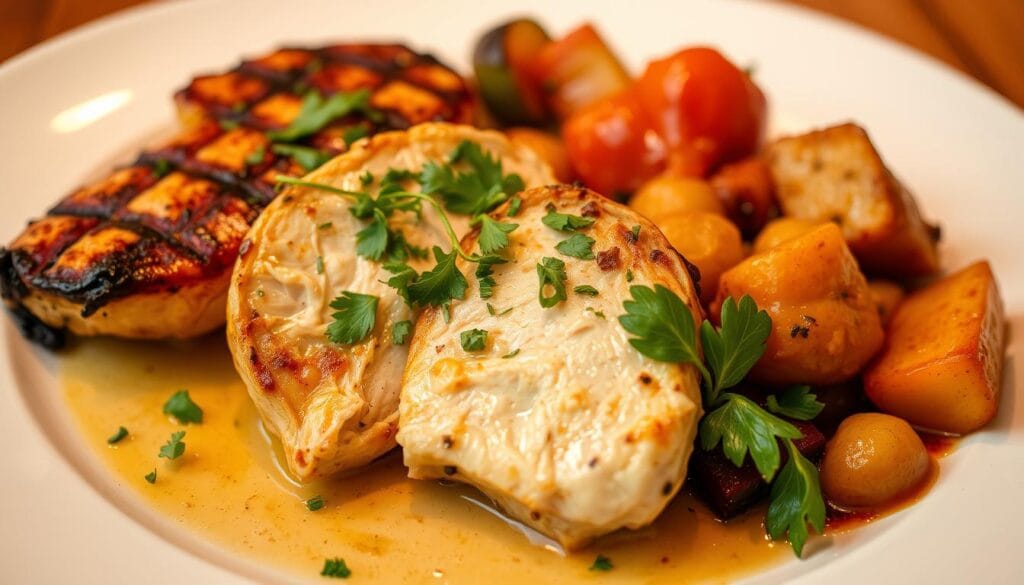
Did you know brining chicken for 15 minutes boosts flavor? Brining for 30-60 minutes makes it even better. These simple steps can make your chicken amazing, making every meal special.
Ready to change your chicken cooking? We’ll cover brining and temperature control. Say goodbye to dry chicken and hello to delicious meals. Everyone will want more!
Understanding Different Chicken Cuts and Their Effect on Tenderness
Knowing your chicken cuts is key to mastering chicken marinating techniques and chicken meat tenderizing tricks. Each part of the chicken has unique characteristics that affect how it cooks and tastes.
Selecting the Best Cuts for Tender Results
White meat, like chicken breast, is leaner and cooks quickly. It’s packed with protein and vitamins B12, B3, and B6. Dark meat, found in thighs and drumsticks, has more fat, iron, and zinc. Understanding these differences is key in mastering how to cook tender chicken, as the composition of each cut impacts tenderness and cooking methods.
Impact of Chicken Part Selection on Cooking Methods
The cut you choose affects how you should cook it. Chicken breast, with less connective tissue, needs careful cooking to avoid dryness. Aim for an internal temperature of 165°F (75°C). Thighs and drumsticks are more forgiving due to higher fat content.
Role of Fat Content in Meat Tenderness
Fat plays a big role in meat tenderness. Fattier cuts like thighs retain moisture better during cooking. For leaner cuts like breast, mastering how to cook tender chicken involves techniques like brining or marinating to enhance juiciness. Low and slow cooking methods can also help maintain moisture in all chicken parts.
| Cut | Fat Content | Best Cooking Method |
|---|---|---|
| Breast | Low | Grilling, Baking |
| Thigh | High | Braising, Roasting |
| Wing | Medium | Frying, Baking |
Remember, the key to tender chicken lies in understanding each cut’s unique properties and applying the right cooking techniques.
The Science of Brining for Ultimate Juiciness
Brining changes the game for moist chicken. It changes the muscle structure, making the chicken hold more water and taste better. Let’s explore how brine recipes make chicken cooking methods better.
Basic Brine Recipe and Ratios
A basic brine mix is 4 cups of cold water and 6 tablespoons of Diamond Crystal kosher salt. For Morton’s kosher salt, use 4 1/2 tablespoons. Or, 3 tablespoons of fine salt. This mix seasons perfectly without too much salt.
Optimal Brining Times for Different Cuts
Brining times depend on the chicken cut. Chicken breasts do best with 30 minutes to 1 hour. For those learning how to cook tender chicken, brining is a key step, but avoid brining longer than 2 hours to prevent over-salting. Whole turkeys need 12 to 24 hours, while shrimp or scallops require just 15 to 30 minutes.
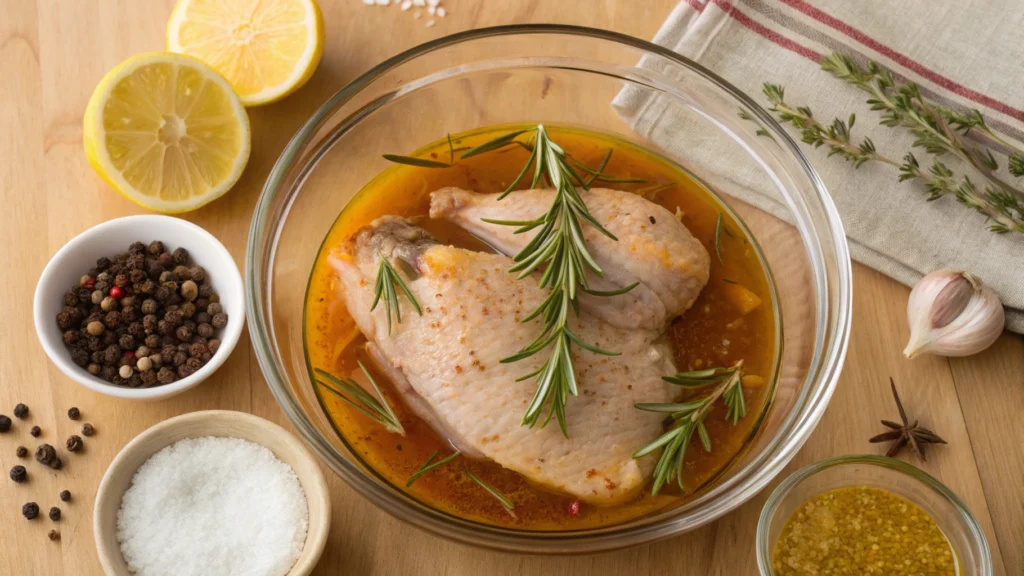
Adding Aromatics to Enhance Flavor
Make your chicken brine recipes better by adding aromatics. Try garlic granules, rosemary, or peppercorns for extra flavor. Remember, brines with herbs are best used within two weeks for the best taste.
| Brine Type | Salt Ratio | Brining Time | Storage |
|---|---|---|---|
| Wet Brine | 1 tbsp kosher salt per cup of water | 1 hour per pound of meat | Up to 24 hours (covered) in refrigerator |
| Dry Brine | 1.5 tsp kosher salt per pound of meat | 30 minutes for boneless chicken pieces | Up to 12 hours (uncovered) in refrigerator |
Mastering brining techniques will make your chicken juicy and flavorful every time. These methods make cooking more forgiving and can even cut down cooking time. This helps keep nutrients in your food.
How to Cook Chicken Very Tender?
Learning how to poach chicken is essential for tender, juicy results. The cold-start method is best for keeping moisture and texture intact.
Cold-Start Poaching Technique
To cook chicken tenderly, start with cold water. Put your chicken in a pot, cover it with water, and heat it slowly to 150-160°F. This method prevents the meat from becoming tough, unlike boiling it directly.
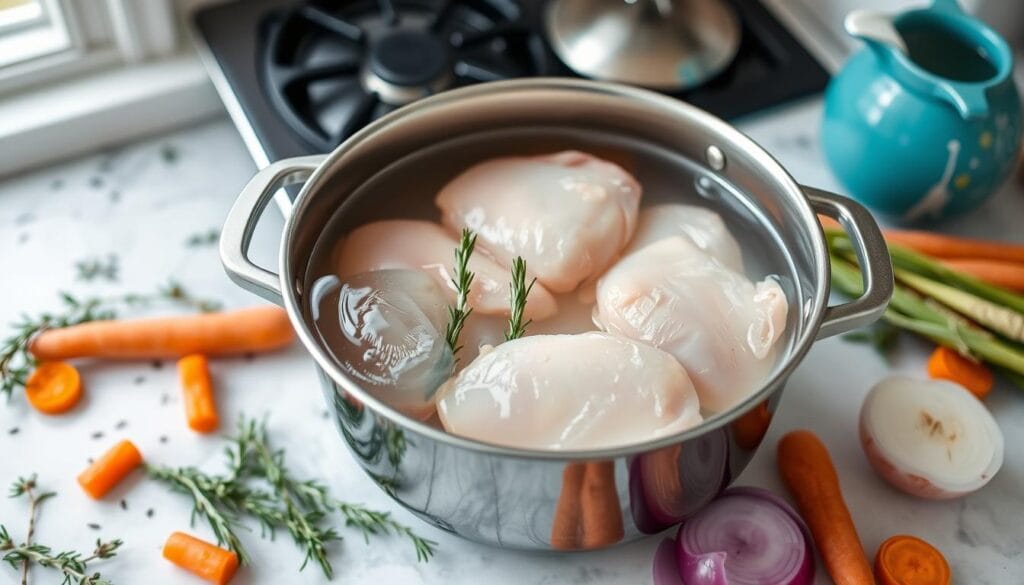
Temperature Control Methods
Use a thermometer to check both water and chicken temperatures. Keep the water at 150-160°F during cooking. This precise control is key for tender chicken.
Timing and Doneness Indicators
Cooking time depends on the chicken’s size. For 3/4 pound breast halves, cook for 30-60 minutes. The chicken is done when the thickest part reaches 150°F.
| Chicken Cut | Weight | Cooking Time | Internal Temp |
|---|---|---|---|
| Breast Halves | 3/4 lb | 30-60 min | 150°F |
| Thighs | 1 lb | 45-75 min | 165°F |
| Whole Chicken | 3-4 lbs | 60-90 min | 165°F |
For more flavor, add onion, garlic, and bay leaf to your poaching liquid. This step boosts taste without losing tenderness.
Essential Marinating Techniques
Learning how to marinate chicken is key to making tender dishes. The right method can greatly improve flavor and texture.
Acid-Based Marinades
Acidic marinades quickly tenderize chicken. Vinegar and citrus-based marinades are great. For boneless cuts, marinate for 30 minutes to 2 hours. Bone-in pieces need 1 to 12 hours.
Be careful not to over-marinate. This can make the meat mushy.
Oil and Aromatics Combinations
Oil and herbs and spices make tasty marinades. Use a one-to-one ratio of spices to liquid, plus half as much salt. Mix olive oil with garlic, rosemary, and lemon zest for a Mediterranean taste.
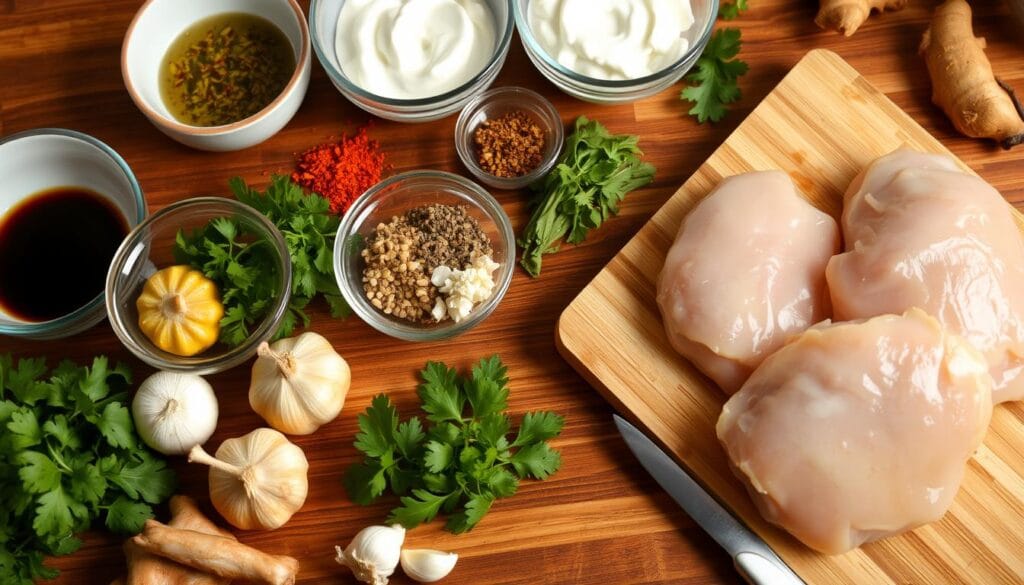
Proper Marinating Times
Timing is key for the best results. Here are some guidelines:
- Boneless chicken: 30 minutes to 2 hours
- Bone-in chicken: 1 to 12 hours
- Creamy marinades: up to 8 hours for boneless, 24 hours for bone-in
Always marinate in the fridge for safety. For a quick flavor boost, try the “reverse marinade” technique. Cook the chicken first, then toss with marinade for 5 minutes after slicing.
| Marinade Type | Ingredients | Best For |
|---|---|---|
| Citrus | Lemon juice, olive oil, garlic | Grilled chicken breast |
| Herb | Rosemary, thyme, white wine | Roasted whole chicken |
| Spicy | Chili flakes, cayenne, vinegar | Chicken wings |
Slow Cooking and Temperature Control
Learning how to slow cook chicken is essential for tender, juicy results. This section will help you improve your cooking skills. You’ll learn how to make delicious chicken dishes.
Low and Slow Method Benefits
Cooking chicken at lower temperatures for longer periods makes the meat tender. Preheat your oven to 325°F and bake chicken breasts for about 60 minutes. This method is great for those who want to cook without constant attention.
Maintaining Optimal Cooking Temperature
Use a meat thermometer to check if your chicken is cooked to 160-165°F. Check the chicken every 3 to 5 minutes towards the end. This helps avoid overcooking, which can make the meat dry and tough.
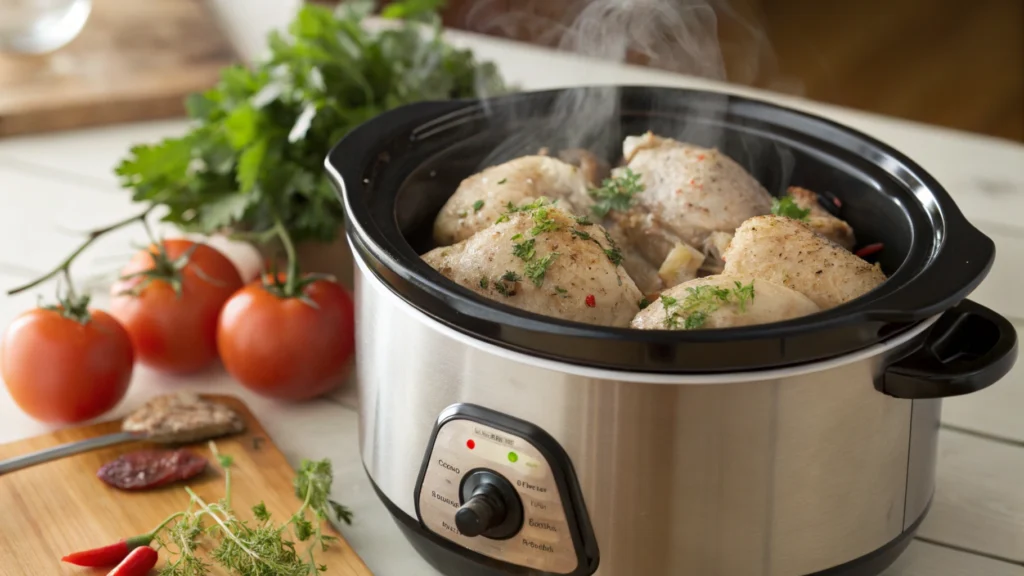
Moisture Retention Techniques
To keep your chicken juicy, try these tips:
- Cover the dish during cooking to trap moisture
- Use a snug-fitting baking dish to prevent excess moisture loss
- Let the chicken rest for 5 minutes after cooking to redistribute juices
| Cooking Method | Temperature | Time | Internal Temp |
|---|---|---|---|
| Slow Roasting | 325°F | 60 minutes | 160-165°F |
| Quick Bake | 400°F | 20-25 minutes | 160-165°F |
By following these tips, you’ll make tender, flavorful chicken dishes every time. Remember, leftovers can be refrigerated for up to 4-5 days or frozen for up to 3 months. This way, you can enjoy your perfectly cooked chicken for a long time.
Professional Tips for Tender Results
Want to make your chicken dishes better? Try these expert tips. First, get a meat thermometer. It’s key for cooking chicken perfectly every time. Cook it to 160°F, then let it rest. This ensures it reaches a safe 165°F, making it juicy.
For crispy skin, dry your chicken before seasoning. This simple step greatly improves texture. When grilling, use a two-zone fire. This helps control temperature, which is vital for moist chicken.
Pan-frying? Start with the skin side down. This method renders fat and crisps the skin well. For tender chicken all over, try sous vide cooking. It ensures even cooking.
- Cut against the grain for more tender meat
- Cube boneless, skinless chicken breast to enhance flavor
- Use pressure to flatten chicken breast for consistency
Boneless, skinless chicken breast is great for home cooks. By using these expert techniques, you can make it taste like restaurant food. Try different cuts to find your favorite texture and taste.
“Cutting chicken breast against the grain or cubing it results in juicier, more fork-tender meat compared to cutting with the grain.”
With these tips, you’re ready to make tender, flavorful chicken dishes. They’ll impress your family and friends.
FAQs
What’s the optimal temperature range for cooking tender chicken?
To cook chicken tenderly, keep the temperature between 150-160°F (65-71°C). This ensures the chicken stays juicy and tender without getting overcooked.
How long should I brine chicken for the best results?
Brine chicken for 15-30 minutes for quick results. For the best effect, brine for up to 2 hours. But, don’t brine longer than 2 hours to avoid over-salting.
What’s the benefit of cold-start poaching?
Cold-start poaching makes chicken more tender. It involves starting with cold water and heating it to 150-160°F. This method cooks the meat evenly and keeps it moist.
How can I ensure even cooking for chicken breasts?
For even cooking, cut large chicken breasts in half. Then, pound them to an even thickness. This helps cook the meat evenly and keeps it tender.
What’s the basic ratio for a chicken brine?
The basic brine ratio is 1 cup of kosher salt per gallon of water. You can also add rosemary, peppercorns, or garlic for extra flavor.
How long should I marinate chicken?
Marinate thin cuts for 30 minutes to 2 hours. Thicker cuts need overnight marinating. Don’t over-marinate to avoid a mushy texture. Use a mix of acid and oil in your marinade to prevent over-cooking.
What’s the best way to cook chicken in the oven for tenderness?
For tender oven-baked chicken, preheat to 400°F (204°C). Bake for 20-25 minutes until it reaches 160°F (71°C). Cover the dish to keep moisture in. Let it rest for 5 minutes after cooking to keep it juicy.
How can I use a sous vide method for tender chicken?
Sous vide cooking seals chicken in a bag and cooks it in a water bath. It ensures tender results by keeping a precise temperature throughout.
What’s the importance of resting chicken after cooking?
Resting chicken for 5 minutes after cooking helps juices spread evenly. This makes the chicken more tender and juicy. It also helps it reach a safe temperature.
How does fat content affect chicken tenderness?
Fat content is key to tenderness. Fattier cuts like thighs stay moist during cooking. This makes them juicier and more tender than leaner cuts like breasts.
Conclusion
Learning to cook chicken very tender is a mix of science and skill. It’s all about knowing the chicken’s structure and using the right techniques. For example, chicken breasts need special care because they have less connective tissue. They should be cooked to 165°F (75°C) for both safety and tenderness.
Getting your chicken ready is key for tender results. Brining or marinating for 12-24 hours can add a lot of juiciness. Even a 30-minute brine can help. Use kosher salt, brown sugar, and herbs for a dry brine to add flavor and keep moisture in.
It’s important to choose the right cooking method for tender chicken. Poaching keeps moisture in, while slow cooking helps control temperature. But remember, longer cooking times don’t always mean softer chicken. Overcooking can make it tough. Always use a meat thermometer to check the chicken’s temperature.
Lastly, let your chicken rest for 5-10 minutes after cooking. This lets the juices spread out, making the chicken tender and juicy.
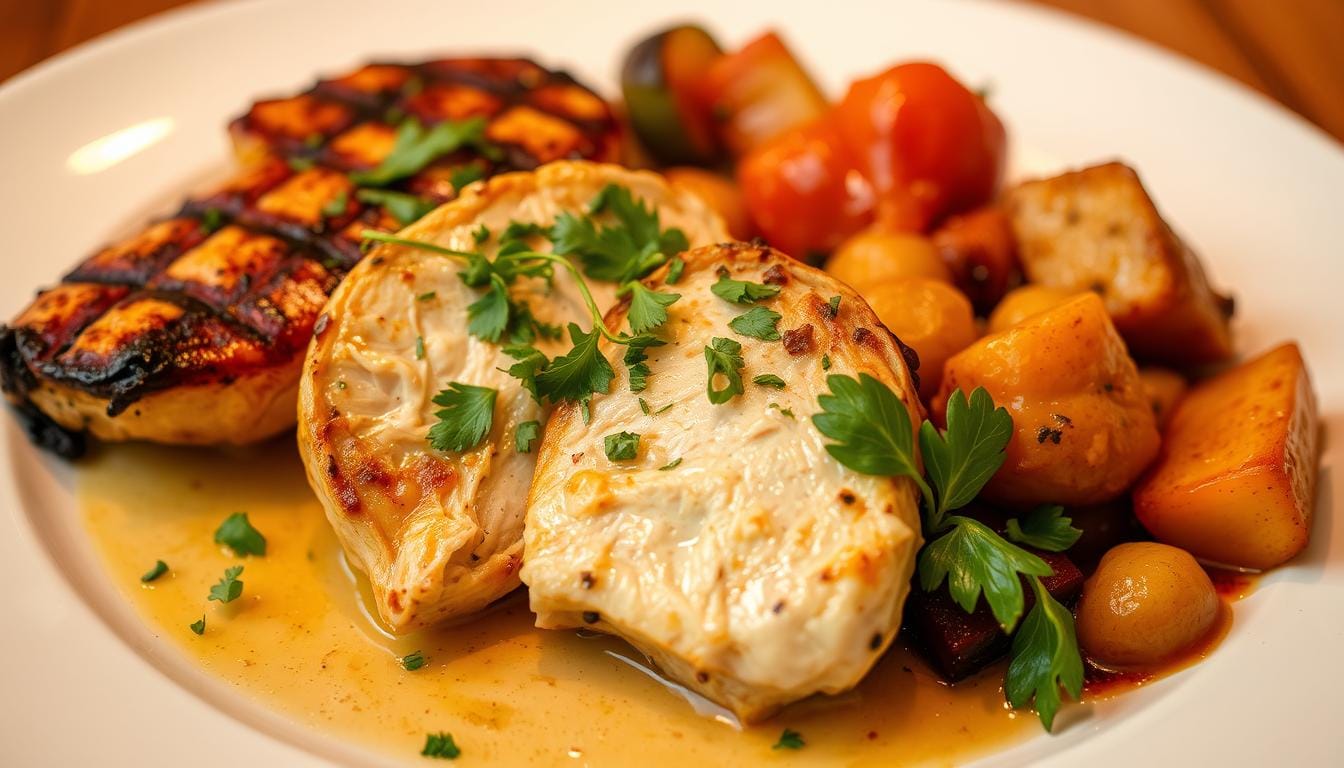
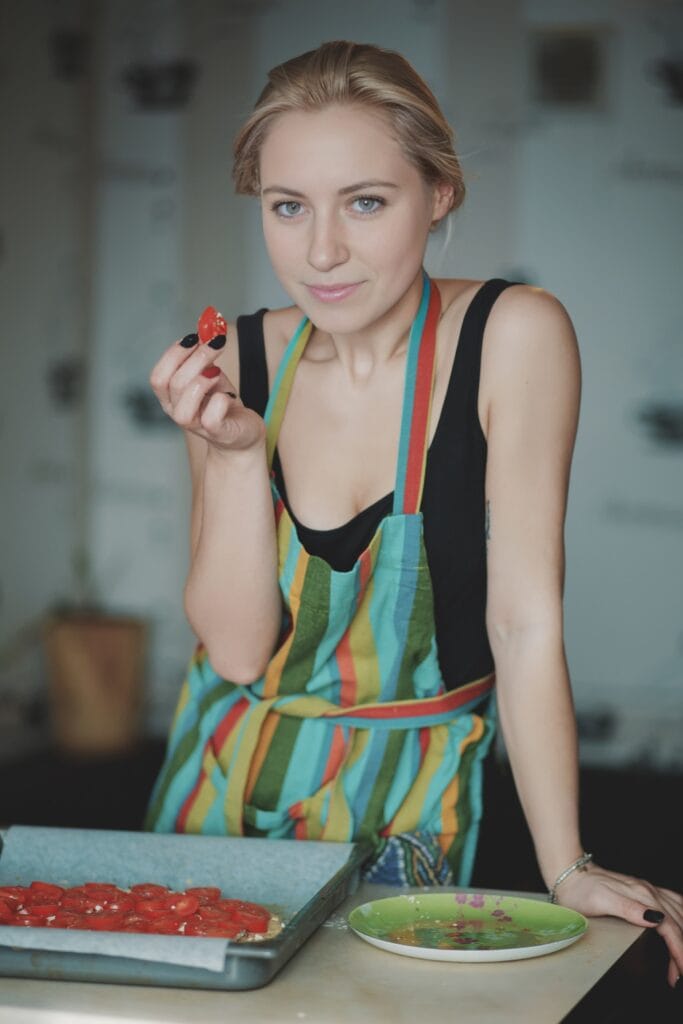
5 thoughts on “How to Cook Chicken Very Tender? Best Methods Revealed”